- NEW DVD Series – Stone Setting with Bezels
- Tube Set Charm by Kim St. Jean
- Prong Basket Pendant by Kim St. Jean
- NEW DVD Series – Stone Setting with Cold Connections
- New DVD Series – Stone Setting with Wire
- NEW DVD Series: Introduction to Stone Setting by Kim St. Jean
- Featured Tool: Bracelet Bending Plier
- NEW Dvd by Eva Sherman
- Fun, Fast Fold Forming DVD Series
- Double Band Ear Cuff from Alex Simkin
Wire Jewelry Idea: Coating Base Metal Wires to Preserve Shine
by Rose Marion, Wire-Sculpture.com
Wire Jewelry Idea: Coating Base Metal Wires to Preserve Shine
Some time ago, Casey Willson left a comment on this popular tip of the day, Prevent Tarnish on Copper and Nickel Silver, mentioning she had a great method for preserving copper wire’s shine, using a generic of Mop N Glo, called Mop N Shine. It wasn’t long before we were flooded with requests for Casey’s secret method!
Casey was gracious enough to share her method with us. While I personally haven’t tried it yet, Casey’s spent the last 9 years developing and perfecting this method. I hope it helps you find a good method of protecting your base metal wire jewelry, too!
Please test this method on scrap wire and spare beads before using this method on your finished jewelry. We cannot guarantee results will be the same for everyone.
Protective Coating for Wire and Base Metal Findings
by P. Casey Willson
Set up items needed:
- Product: Mop N Shine (generic form of Mop N Glow floor polish)
- Newspaper
- Viva paper towels (or other good quality)
- Tray or flat cardboard (optional)
- Long tweezers, crochet hook or old (clean) pliers
- Air tight container
- Water and disposable rag for clean up
- Cotton swabs for cleaning off gems while product is wet.
- Ammonia for cleaning up dried spots on work area.
Advisory:
- DO NOT get this product on good gemstones or cabochons as it will dry blotchy on polished stones. Treat wire or findings ahead of time or with small paint brush to touch up after finishing item or on high wear spots such as bails or pin backs.
- Be sure wire is very clean with no tarnish (patina is just fine if you want to keep it!) or dirt at all. This coating is very hard and difficult to remove when cured.
- Be aware you are working with a polymer and the feel of the wire will be a bit slick. Be sure to include the polymer in your item description. I think it’s a plus, as it prevents tarnish and also reduces allergic reactions to everything except rare allergies to plastic.
- DO NOT dip spring clasps; paint the outside instead. Dipping can lock up the spring mechanism.
Procedure
Pour at least 1″ of dip into your air tight container. I prefer a 6″ to 8″ by 3″ oblong container or 3′ to 6″ large round one that will hold at least 2″ of dip with a 2″ clearance above the liquid level for safety. With these sizes you can dip a coil of wire without any bends being created.
Place wires or findings in dip without splashing. It can be removed immediately with fingers if you prefer but better with long tweezers, a crochet hook or old pliers. The dip WILL freeze the joint of the pliers if you allow it to dry in the joint so hold them nose down and dry them nose down.
Let excess drip off then lightly drop on newspaper and paper towel lined tray. Stretch your wire coil (or separate multiple findings) so the dip does not dry on two connected items. You want to avoid rough spots this may create. We’re after a smooth, thin coating. Curing time is short. Generic brands cure faster. Allow at least ten minutes for hard curing.
If item being dipped (such as a base metal cab setting) has “holes” or filigree, be sure to lightly blow through the holes to prevent a film from forming.
If dipping a finished base metal piece or chain hang from a pin or hook above your absorbent pad to let any excess drip off. Chains will be a little bit stiff but just run them through your fingers when dry and they will be fine. We work with wire so any of us can make a stand from which to hang these pieces from stiff wire (coil the base, then make an arched rise with a hook on the end).
Touch up (with small paint brush) any places where pliers may have broken through dip coating while you were working with it.
Notes and Cautions
I will also dip inexpensive porous cabochons that I use in practice pieces. It works as a hardener for soft stones such as chalk turquoise and as a color fixer for dyed stone. DO NOT use on highly- polished hard stones or beads!
DO NOT use on any thread if you use thread in your work. It will make the thread brittle so it breaks. DO NOT use on leather. DO use as a sealer on acrylic painted items.
Double-dipping high wear items is a good thing. Be sure coating is cured between dippings.
Always test materials other than wire before using dip.
Product cleans up easily with water when wet. Tools like paint brushes or crochet hooks should be kept in water between uses, then dried when you finish. Avoid shaking wet items excessively as droplets may get on work surfaces and any nearby carpet or even on your clothing, then be missed.
Please practice methods before using on important pieces!!!!
I’ve developed this method over about 9 years of jewelry making in various styles and it has worked for me quite well. I love the fact that with this dip I can wear base metal ear wires! When I make copper or brass earrings I want the findings to match!
I kept this as my “secret process” for almost six years. Now I’m sharing it freely with hopes that you all benefit.
Credits: In “The Art of Painting on Rocks” by Lin Wellford this material was suggested as a paint protective coating. I took the idea further. My thanks to Lin.
P. Casey Willson
Wire-Sculpture does not guarantee any results from this method, and is not liable for any damage caused by this method. Please be sure to test this method and become familiar with it before transferring it to any finished jewelry pieces.
Have a Wire Jewelry Idea you’d like to share? Click Here to submit your idea. You could be featured on our Blog!
Click to Receive Daily Tips by Email







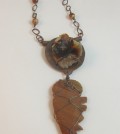
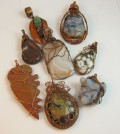

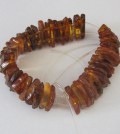

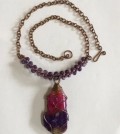
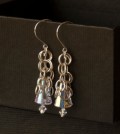
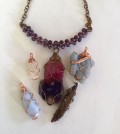
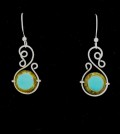
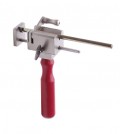
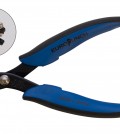
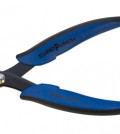
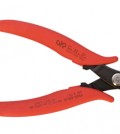
Jan Fulwiler
November 30, 2011 at 10:26 am
I put the mop and glo on some copper bracelets, tried painting carefully annd it did not work, milky white and green spots, how do I get it off? can I get it off? or are the bracelets ruined? help jan
Rose
November 30, 2011 at 12:48 pm
Hi Jan,
While I’m not sure how to remove Mop N Glo, here’s how Katheryn Kienle removed Nufinish, a similar product, from her jewelry:
“To remove NuFinish or any polymer based wax, any really strong solvent will work well. I used paint thinner to remove the NuFinish. Acetone from the hardware store would probably have worked well too (Nail Polish is watered down so it didn’t work). Just be sure to rinse with water really well after cleaning with any solvent.”
Mop N Glo’s website recommends this formula for removing the product from floors (don’t get it on stones): 1/4 cup all purpose cleaner (such as Lysol) to 1 cup ammonia in 1/2 gallon of warm water.
Hope that helps!
Rhonda Chase
November 30, 2011 at 3:20 pm
I’ve been doing this to my polymer clay jewelry for a while. We don’t have Mop n Shine where I live, so I get Pledge floor care. I find it works best when heat set. If I have milky spots they usually dry clear after I take a heat gun to the finish. I would experiment first so you don’t damage your bracelets! For sealing metals (I love working with copper) my favorite product is Protect a Clear from Everbrite. It seems expensive at first, but the smallest jar has lasted me over a year.
Lynne Hopkins
August 14, 2012 at 6:40 am
I agree with you, Rhonda. Protect a Clear from Everbrite is the best!
P Casey Willson
September 9, 2014 at 7:16 am
Ammonia will dissolve it.
chris
November 30, 2011 at 11:04 am
Great Tip! Thank you!
Linda Overman
November 30, 2011 at 11:41 am
Wanted to thank Casey for sharing her procedure to prevent tarnish on base metals. I’ll be trying this one soon, will post again with my results but have to wait until my finger heals:)
lindacay
November 30, 2011 at 12:30 pm
Thank you for this great tip. I will be trying this in the near future.Lindacay
Jilly W
November 30, 2011 at 12:57 pm
I just use Renaissance wax. Pricey, but lasts darn near forever/
Cindy Booth
November 30, 2011 at 2:16 pm
I have a question. Will this coating make my wire slippery-er to work with? I confess, that’s why I haven’t tried it yet.
Tammy
November 30, 2011 at 3:56 pm
Hi Dale
I am a spirratic reader of the daily tips for making wire jewelry because 90% percent of it I already know about and have tryed it. When I see helpful tips like this I like to copy and paste them into my file of tips and tricks to the trade. Thanks so much.
Linda Keesee
December 1, 2011 at 8:24 am
Great tips. Thank you for sharing.
DeLane Cox
December 1, 2011 at 3:58 pm
I recently heat-colored some copper pieces for jewelry, then cleaned and coated them with ProtectaClear. Love it! Did find that it dries better if you hit it with a hot hair dryer for a few seconds, but it will also air dry. It leaves the piece shiny, not mat, but does not bother the color. It is a bit pricy, buy I think it is worth the cost. I have not tried it on ear wires,since I use silver and gold-filled ones. I might give it a try on ear wires that I make to go with the copper jewelry and see what the results are.I would expect the same as on the pieces,however.
Katherine
December 1, 2011 at 10:58 pm
would you coat sterling silver with any of these products?
P Casey Willson
September 9, 2014 at 7:22 am
I use it on sterling because of the nickle content and because it tarnishes so quickly in humid locations.
One thing I failed to include in the instructions is that people with a really high acid skin will still burn through a single or even double coat sometimes.
On cuff bracelets I use car wax, buffed hard with my dremel and reapplied as often as needed.
I’ve found there is no single solution to anything since pieces are different as are people!
Lori Crawford
December 7, 2011 at 7:06 pm
Great tip! I will be trying this the next time I make something in copper. Thanks again for the great tips!
Jan Scranton
May 21, 2012 at 8:16 pm
I work mostly in copper and was wondering what I could use to keep the ‘green’ reaction from happening when copper touches skin for any length of time. This seem to be the ticket!
Brenna
August 14, 2012 at 9:37 am
Thanks for the tip:) It’s a nice procedure to have if I ever want to take that extra step. I have limited time so anyting extra gets over whelming.
Anyhow, for my copper jewelry when I get tired of the patina and I want to get that beautiful pink/brown metal back I just use lemon and salt no water. Au Natural. I pass this on to my cutomers, I’ve just come to the conclusion people like copper for it’s natural aging/use process.
Jinsonjp
March 21, 2013 at 9:33 am
Hi, Brenna. Thanks for the lemon/salt tip. Is there a specific amount of each that you use?
JILLRY
August 14, 2012 at 10:03 am
I’ve found this also works well on gold-plated costume jewelry, provided you have plenty of cotton swabs, coffee filters and patience, absorbing the mop n glo from settling into crevices, and pressing it off from the top of crystal rhinestones, before it dries.
I also recently used it on gold-plated findings, which until now i’ve refused to use due to their unacceptable temporary quality issues.
It didn’t hurt, and can only help!!!
Note: once, i was talking away and forgot to remove some acrylic rhinestone pieces, and discovered within a few minutes that their colors had bled off into my dip. They were just fine upon removal, though, and i simply patted the mop n glo off the tops of the stones with a coffee filter! So, be brief!
Lori
August 15, 2012 at 6:46 am
Thanks so much for sharing your tip your tip. It was very well wrote. And I will be trying it very soon!
Sandra
October 4, 2012 at 8:51 am
Hi! I was so excited when I heard about this I went out and bought MOP n Glo (couldn’t find Mop N Shine). I must not be doing it correctly because my copper rings still turn my daughters fingers after a day. I guess I have to find Mop n Shine and try that to see if it is different. Thanks for the tip. Wish it worked!
silberschmuck
January 3, 2013 at 11:27 am
Danke für den Tipp Es ist ein schönes Verfahren zu haben, wenn ich jemals wollen, dass zusätzliche Schritt zu machen. Ich habe Zeit begrenzt, so zusätzliche bekommt über überwältigend.
Es ist ein schönes Verfahren zu haben, wenn ich jemals wollen, dass zusätzliche Schritt zu machen. Ich habe Zeit begrenzt, so zusätzliche bekommt über überwältigend.
Jedenfalls für meine Kupfer Schmuck, wenn ich müde von der Patina bekommen, und ich will das schöne rosa / braun Metall zurück bekomme ich einfach Zitrone und Salz kein Wasser. Au Natural. Ich gehe diese auf meine cutomers, ich habe gerade zu dem Schluss, die Menschen wie Kupfer für seine natürliche Alterung / Nutzung Prozess kommen Silberschmuck.
(Translation) It’s nice to have a method, if I ever want to make that extra step. I have limited time, so it gets very, very overwhelming.
It’s nice to have a method, if I ever want to make that extra step. I have limited time, so it gets very, very overwhelming.
Thanks for the tip
Anyway for my copper jewelry when I get tired of the patina, and I want that beautiful pink / brown metal back I just get lemon and salt no water. Au Natural. I go to my cutomers this, I just concluded that people like copper for its natural aging / usage process come silver jewelry.
Sandy
April 16, 2013 at 11:08 am
Such wonderful advice! I was intrigued and pulled my old wax out from the back of the shelf. It says “Future, commercial line. Tough Acrylic action” I was thinkin g acrylic, plastic….polymer. When I looked up this products msds sheet on google (LOVE IT!!!), it listed c-polymer. This is basically polymer.
Conclusion: I think any product, particularly products for shine purposes, that have a claim of tough acrylic action (lol!), or polymer listed in the ingredients ,can be used to seal out oxidation!
Sooooo, Im gonna try what is already paid for before purchasing a brand new product. Sage advice tho, or Id not even know to DO THIS! Woo Hoo!!!! Excellent advice and thanks yall! I too hope I too works on silver:?)
Sandy
PS- Please excuse lousey punctuation, typing , spelling and anything else I missed. Ive adult adhd, and a bunch of other abbreviations!LOL!I get by.
Rory
September 9, 2014 at 6:14 pm
Yes, I’ve been using Future brand floor wax for this property for several years! Great minds, and such…
Way to go, Casey!
Peggy Powers
April 30, 2013 at 3:25 pm
I found this tip interesting. I’d like to know what is the difference between this and just buying “non-tarnish” wire. I was recently told to NOT hammer the non-tarnish wire. I have to admit I was very confused by this. What about hammering wire with Casey’s method? Perhaps someone can tell me why you shouldn’t hammer non-tarnish wire? The person that told me this didn’t elaborate so I’m honestly confused. I’ve hammered the wire with a mallet just to harden it and haven’t any problem. So what is the difference between Casey’s method and buying the non-tarnish wire?
Shannon
June 8, 2013 at 8:41 pm
Hi Peggy,
The reason you can’t hammer non-tarnish wire is because the non-tarnish coating can not withstand rough treatment. Non-tarnish wire is just wire that has an enamel coating (or other protective layer) over it to prevent oxygen and other things such as salts, oils, etc. from contacting the surface and starting the oxidization reaction/tarnish. Although non-tarnish sounds like a nice option for working with metal there are definite draw backs and limitations. Non-tarnish is something I do not work with due to those limitations. In my opinion using a polymer coating as suggested in the tip above, or using a Varathane/urethane coating, PermaLac, or ProtectaClear by Everbright (which is what I use is the best option for keeping your creations looking like they did when you initially completed them.
I hope this answered some of your questions and concerns. Good luck on your artistic journey!
June Frost
June 26, 2014 at 11:50 am
This is a great tip for me because I love to use copper wire. My question is: what about untreated stainless steel wire? Will this work on it, or is there something else I need to keep the steel shining and my male customers happy? Thanks & God bless!
P Casey Willson
September 9, 2014 at 7:18 am
I use it on ALL base metals (have never had the problem of it turning white so no idea why THAT happened) and I also use it on sterling because of the nickle content.
Terrie Bodine
November 18, 2014 at 11:19 am
I haven’t read if we are supposed to coat the wire before or after making our piece. If we coat before making, will the coating rub/chip off during handling with pliers, etc.?
Beth
March 1, 2016 at 7:06 pm
We don’t have this product Mop & Glow or Shine, in Australia. Does anyone know an Australian eqivalent?